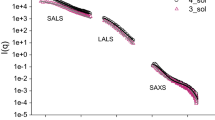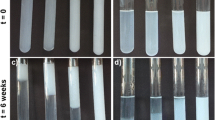Abstract
Investigations of structure formation in linear and cross-linked polymer systems including one based on xanthan, an exopolysaccharide, attract theoretical and practical interest because of their widespread applications. Freeze-fracture transmission electron microscopy is used to study the structural topology formed in aqueous xanthan solutions and xanthan hydrogels. The data enable us to visualize for the first time an intact structure of xanthan formed in dilute and semidilute solutions at concentrations ranging from 0.002 to 0.5 wt %. In addition to single macromolecules, the dilute xanthan solutions are shown to contain microgels. When the concentration grows to values close to an overlap concentration (C*), a weak gel structure appears, being composed by a continuous 3D network with relatively large meshes. Macromolecular aggregation is observed in the network skeleton when switching to semidilute entangled solutions (>C**); it is accompanied by a compaction of network structure. The cross-linking of polymer chains by polyvalent Cr3+ ions gives a network skeleton composed of aggregated macromolecules at lower concentrations (around C*). Macromolecular aggregation in the skeleton of a network polymer structure occurring both in the absence and in presence of Cr3+ cations is indicative of a microphase separation into polymer-poor and polymer-rich regions.
Similar content being viewed by others
References
I. T. Mishchenko, Downhole Oil Production (Ros. Gos. Univ. Nefti Gaza im. I. M. Gubkina, Moscow, 2003) [in Russian].
M. B. Smith and C. T. Montgomery, Hydraulic Fracturing (CRC, London, New York, 2015).
J. K. Fink, Hydraulic Fracturing Chemicals and Fluids Technology (Gulf Professional, Elsevier, USA, 2013).
J. K. Fink, Oil Field Chemicals (Elsevier Science, USA, 2003).
L. Kh. Ibragimov, I. T. Mishchenko, and D. K. Cheloyants, Intensification of Oil Production (Nauka, Moscow, 2000) [in Russian].
T. Sato, T. Norisuye, and H. Fujita, “Double-stranded helix of xanthan: dimensional and hydrodynamic properties in 0.1 aqueous sodium chloride,” Macromolecules 17, 2696–2700 (1984).
T. Sato, S. Kojita, T. Noritsuye, and H. Fugita, “Double- stranded helix of xanthan in dilute solution: further evidence,” Polym. J. 16, 423–429 (1984).
T. Lund, O. Smidsrod, B. T. Stokke, and A. Elgsaeter, “Controlled gelation of xanthan by trivalent chromic ions,” Carbohydr. Polym. 8, 245–256 (1988).
P. W. Chang, L. A. Burkholder, J. C. Philips, M. Ghaemmaghami, M. A. Myer, and R. E. Babcock, “Selective emplacement of xanthan/Cr(111) gels in porous media,” SPE Paper No. 17589, pp. 411–421.
J. S. Tsau, J. T. Liang, A. D. Hill, and K. Sepehrnoorl, “Re-formation of xanthan/chromium gels after shear degradation,” SPE Reservoir Eng., pp. 21–28 (1992).
R. W. Eggert, G. P. Willhite, and D. W. Green, “Experimental measurement of the persistence of permeability reduction in porous media treated with xanthan/Cr(lll) gel systems,” SPE Reservoir Eng., pp. 29–35 (1992).
M. Bergmeier, M. Gradzielski, H. Hoffmann, and K. Mortensen, “Behavior of a charged vesicle system under the influence of a shear gradient: a microstructural study,” J. Phys. Chem. B 102, 2837–2840 (1998).
D. A. Coleman, J. Fernsler, N. Chattham, M. Nakata, Y. Takanishi, E. Korblova, D. R. Link, R.-F. Shao, W. G. Jang, J. E. Maclennan, O. Mondainn-Monval, C. Boyer, W. Weissflog, G. Pelzl, L.-C. Chien, et al., “Polarization-modulated smectic liquid crystal phases,” Science 301 (1204), 1203–1211 (2003).
J. Hao, J. Huang, G. Xu, L. Zheng, W. Liu, and H. Hoffmann, “Freeze-fracture transmission electron microscopy studies on the self-assemblies of amphiphilic solutions,” Sci. China, Ser. B 46, 567–576 (2003).
J. Hao and H. Hoffmann, “Self-assembled structures in excess and salt-free catanionic surfactant solutions,” Curr. Opinion Colloid Interface Sci. 9, 279–293 (2004).
W. Jahn and R. Strey, “Microstructure of microemuisions by freeze fracture electron microscopy,” J. Phys. Chem. 92, 2294–2301 (1988).
H. Yang, J. Wang, S. Yang, and W. Zhang, “Aggregate conformation and rheological properties of didodecyldimethylammonium bromide in aqueous solution,” J. Dispers. Sci. Technol., No. 31, 650–653 (2010).
T. A. Camesano and K. J. Wilkinson, “Single molecule study of xanthan conformation using atomic force microscopy,” Biomacromolecules, No. 2, 1184–1191 (2001).
I. Capron, S. Alexandre, and G. Muller, “An atomic force microscopy study of the molecular organisation of xanthan,” Polymer 39, 5725–5730 (1998).
M. Iijimaa, M. Shinozakib, T. Hatakeyamac, M. Takahashid, and H. Hatakeyamae, “AFM studies on gelation mechanism of xanthan gum hydrogels,” Carbohydr. Polym. 68, 701–707 (2007).
H. Li, M. Rief, and F. Oesterhelt, and E. H. Gaub, “Single-molecule force spectroscopy on xanthan by AFM,” Adv. Mater. 3, 316–319 (1998).
M. J. Miles, I. Lee, and E. D. T. Atkins, “Molecular resolution of polysaccharides by scanning tunneling microscopy,” J. Vacuum Sci. Technol. B 9, 1206–1209 (1991).
A. P. Gunning, T. J. McMaster, and V. J. Morris, “Scanning tunnelling microscopy of xanthan gum,” Carbohydr. Polym. 21, 47–51 (1993).
M. J. Wilkins, M. C. Davies, D. E. Jackson, J. R. Mitchell, C. J. Roberts, B. T. Stokke, and S. J. B. Tendler, “Comparison of scanning tunnelling microscopy and transmission electron microscopy image data of a microbial polysaccharide,” Ultramicroscopy 48, 197–201 (1993).
M. J. Wilkins, M. C. Davies, D. E. Jackson, C. J. Roberts, and S. J. B. Tendler, “An investigation of substrate and sample preparation effects on scanning tunnelling microscopy studies on xanthan gum,” J. Microsc. 172, 215–221 (1993).
V. B. Bueno, R. Bentini, L. H. Catalini, and D. F. S. Petri, “Synthesis and swelling behavior of xanthan-based hydrogels,” Carbohydr. Polym. 92, 1091–1099 (2013).
D. Yu. Mityuk, D. A. Muravlev, A. V. Shibaev, and O. E. Philippova, “Study of polyvalent metal ions binding by polymer ligands,” Tr. Ross. Univ. Nefti Gaza Gubkina, No. 3 (208), 108–117 (2015).
M. Milas, M. Rinaudo, B. Tinland, and G. de Murcia, “Evidence for a single stranded xanthan chain by electron microscopy,” Polym. Bull. 19, 567–572 (1988).
E. Dickinson, “Microgels—an alternative colloidal ingredient for stabilization of food emulsions,” Trends Food Sci. Technol. 43, 178–188 (2015).
J. G. Southwick, A. M. Jamieson, and J. Blackwell, “Quasi-elastic light scattering studies of semidilute xanthan solutions,” Macromolecules 14, 1728–1732 (1981).
J. G. Southwick, A. M. Jamieson, and J. Blackwell, “Conformation of xanthan dissolved in aqueous urea and sodium chloride solutions,” Carbohydr. Res. 99, 117–127 (1982).
W. E. Rochefort and S. Middleman, “Rheology of xanthan gum: salt, temperature, and strain effects in oscillatory and steady shear experiments,” J. Rheol. 31, 337–369 (1987).
A. B. Rodda, D. E. Dunstanb, and D. V. Bogera, “Characterisation of xanthan gum solutions using dynamic light scattering and rheology,” Carbohydr. Polym. 42, 159–174 (2000).
P. D. Oliveira, R. C. Michel, A. J. A. McBride, A. S. Moreira, R. F. T. Lomba, and C. T. Vendruscolo, “Concentration regimes of biopolymers xanthan, tara, and clairana, comparing dynamic light scattering and distribution of relaxation time,” PLoS ONE 8, e62713 (2013).
K. Nakamoto, Infrared and Raman Spectra of Inorganic and Coordination Compounds (Interscience, New York, 1986).
Author information
Authors and Affiliations
Corresponding author
Additional information
Original Russian Text © A.E. Chalykh, V.V. Matveev, D.A. Muravlev, D.Yu. Mityuk, O.E. Philippova, 2017, published in Rossiiskie Nanotekhnologii, 2017, Vol. 12, Nos. 1–2.
Rights and permissions
About this article
Cite this article
Chalykh, A.E., Matveev, V.V., Muravlev, D.A. et al. Nanostructure of xanthan networks. Nanotechnol Russia 12, 1–8 (2017). https://doi.org/10.1134/S1995078017010037
Received:
Accepted:
Published:
Issue Date:
DOI: https://doi.org/10.1134/S1995078017010037




